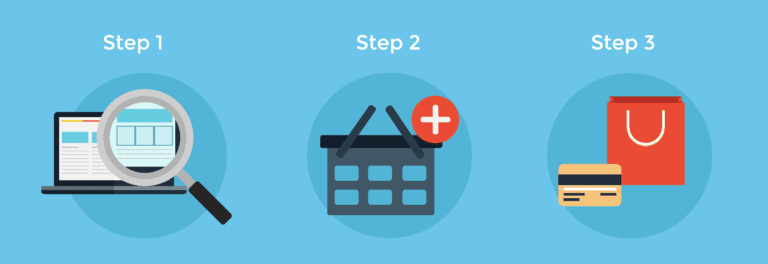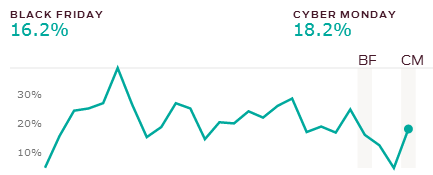Ecommerce Conversion Checklist: 25 Quick Wins to Drive More Revenue

Having an ecommerce site isn’t just as easy as having the products to sell and waiting for buyers to flock to your site. After all, without boosting your site’s conversion rate, you’re least likely to get the exposure you want to even sell anything.
Working with thousands of ecommerce websites throughout the years, we’ve seen what works and what doesn’t. Using our own experience in ecommerce SEO as a starting point, we’ve created this ecommerce conversion rate checklist to help online stores rake in more business.
1. Rank for main ECOMMERCE SEO keywords.
This includes your brand name, products, and categories. Spend the majority of your PPC marketing budget on these keywords because these are the ones that will drive conversions to your ecommerce site. Ranking for your brand terms is important to catch navigational searches, which target users who are specifically looking for your business.
2. Find keywords for the homepage.
Your homepage is often the first page that users visit. You may direct a couple of keywords here and there, but make sure you are not targeting a product term as the main keyword for this page — that is unless you are only offering one product for the entire site. Otherwise, keep each product-related keyword to their own landing pages to drive maximum traffic.
3. Look for the low hanging fruit.
If competitors have more high-ranking pages, work on a different set of keywords to improve your overall conversion rate. Look for keywords with a good search volume and concentrate your efforts on the ones that you can rank for quickly, so you can start gaining online traction.
4. Use keywords that your competitors are not targeting.
What better way to get past your competition than to target their blind side? Because competitors are not using these terms, you may get your site to rank for these keywords more easily. It might take a little extra keyword research to see which keywords they haven’t cracked yet, but if you have a dedicated keyword analyst to help you, it’ll be easier.
5. Find high-converting keywords.
Use a keyword explorer to check a competitor site for keywords that are working well for them. For instance, if they have a “best computers for students” keyword, look for keywords related to “best computers”. You can also try a Google search to look for related terms.
6. Engage AND educate.
Be more than a click-bait site. Offer something valuable, such as infographics and facts relating your product to your customer’s needs. This balances the content on your product pages as well, because ecommerce sites need not be text-heavy and purely sales-y.
7. Target “opportunity keywords”.
You may have some keywords that are ranking low on the SERPs but have a good search volume and a low difficulty score. Target these keywords and use long-tail variations to rank for general terms and phrases.
8. Outrank websites on the first page of SERPs.
Not everyone on the SERPs are big sites. With a foolproof ecommerce SEO strategy, you can outrank websites and make your own more visible to customers. Check how many outbound and inbound links they have. If they have fewer inbound links than yours, you may have a chance at outranking hem. All it takes is implementing some changes on your target pages and reaching out to authoritative websites.
9. Change page titles to attract attention.
Don’t use boring and generic page titles. Your page title should be easy to understand while also being worthy of getting clicks. Include the name of the brand and the product found on that page when writing the page title. Words such as “discount,” “25% off,” and “free” may also boost traffic.
Pro-tip: Check the results pages and see how top-ranking pages format their titles.
10. Fill “content gaps”.
Your site may be ranking for keywords that you are not targeting yet. This is a good opportunity to optimize the site for those specific keywords. Use Google’s Keyword Planner tool to see which terms you’re ranking for, and create a dedicated landing page for these keywords.
11. Switch to https.
Ecommerce sites often require submitting important information. Consumers are likely to transact with your business if you use the “https” architecture. This also tells Google that you are more trustworthy than a regular “http” site.
12. Optimize category pages by adding unique content.
Category pages are not just placeholders — Google still indexes these pages. Check your Google Analytics account for indexed category pages that show duplicate entries. You can also try using “site:http://website.com” search to find out how many of your pages are indexed by Google, including the category pages.
13. Use consistent title tags.
This makes titles easier to organize, and also shows the general trend of your pages. This helps Google rank your site while helping your customers understand your website architecture. Make sure your title tags don’t have any duplicates across your site.
14. Add original content for each product.
It’s easy to assume that no one will be reading the product descriptions. But, as an ecommerce site owner, you can’t run the risk of Google flagging your site for duplicate content. Add a few paragraphs of keyword-optimized content to be on the good side of search engines.
15. Headers should contain the product name and secondary keywords.
Using headers with target terms can help you rank for relevant keywords. Include the brand and the product name, as well as secondary keywords that you’re targeting for the page. Secondary keywords should be variations of the primary keyword belonging in the same keyword group. Don’t try to target two main keywords in one page.
16. Write optimized and attention-grabbing Meta descriptions.
Meta descriptions are snippets of what your page is about, which is why generic content will never work if you want to boost click-throughs. You also need to be mindful of the character limit, and use action words to prompt customers to visit the site.
17. Optimize product images.
Some ecommerce sites may have multiple images per page. Rather than adding big images, compress the size so that your site’s loading speed will not be affected. Don’t forget to provide an alt text and caption to help Google crawl your images.
18. Remove the boilerplate text on the footer.
Some ecommerce site owners argue that the boilerplate information is essential to the brand’s website, but that block of text on your footer may be misinterpreted as low-quality, spammy content. Remember that Google indexes each page individually. Seeing the same content over and over again will not bode well for your rankings.
19. Avoid keyword cannibalization.
Yes, you may target more than one keyword for a particular landing page, but you should only have one main keyword for each page. Use secondary keywords and variations instead, so that you are not cannibalizing traffic from another page that may be targeting the other keyword.
20. Check your competitor’s site architecture.
Check how your competitors structure their pages – from the categories to the tags, and how deep their link architecture go. If it works for them, they may be onto something that you can adapt to your website.
21. Check internal linking.
Site visitors shouldn’t have to go through so many pages just to get to the a particular page they want. Make sure your site is easy to navigate, and that each page is accessible with a few clicks. Use internal link building to direct them from one page to another page that is relevant to their needs.
22. Improve social media integration.
Customers usually check social media for product reviews and more information about your brand. Make the information they need accessible to them, so they can make an informed choice. Give them a way to contact you through these channels, as well.
23. Use user-friendly URLs.
If customers see gibberish on your URLs, they won’t click on that link. Rather than showing random numbers on your site URL, use the category and the product name when creating URLs. You can easily change this in your website’s settings, and even set the canonical URLs.
24. Improve your site’s usability.
Offer them assistance even before they ask. Customers say that having a live chat feature to answer their queries in the middle of a purchase is one of the best functionalities of a good ecommerce website because it allows you to tap into customer pain points.
25. Make your ecommerce site mobile-friendly.
You should have a mobile-friendly website design. After all, many of your customers are likely using their mobile devices while shopping and completing transactions. You’re missing a lot if your site is not optimized for mobile.
If you’re looking to dominate the online marketplace, now’s the time to put this ecommerce guide into use.
Having useful items to sell on your ecommerce site is just one part of the business; you need to make sure your selling platform provides customers with a smooth experience. By implementing the best practices to optimize your ecommerce site, it may only be a matter of time before your conversion rate starts going up.










